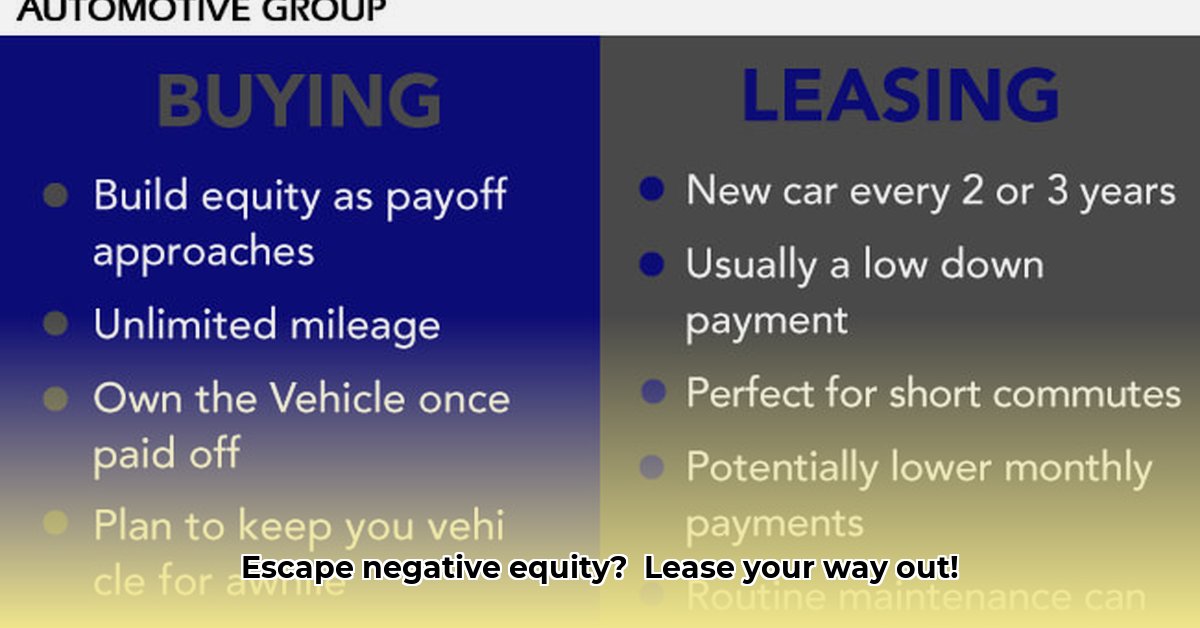
Facing negative equity—owing more on your car than it's worth—can feel overwhelming. But don't despair! With a strategic approach, you can leverage this situation to secure a better deal on your next vehicle, whether through leasing or financing. This guide provides actionable steps to navigate this challenge successfully.
Understanding Your Underwater Car Loan
Negative equity occurs when your car loan balance exceeds your car's current market value. Common causes include high interest rates, lengthy loan terms, and the rapid depreciation of vehicles. Ignoring this problem won't make it disappear; it will likely worsen, impacting your credit score and future financing options. Before exploring leasing options, honestly assess your negative equity amount. Online valuation tools can help determine your car's current market value. Tools like Kelley Blue Book and Edmunds can provide you with more accurate estimations based on your vehicle's specifics to help you quantify the issue.
Leasing vs. Financing: Which Path Suits You?
When dealing with negative equity, leasing or financing a new vehicle presents distinct advantages and disadvantages.
| Feature | Leasing | Financing |
|---|---|---|
| Monthly Payments | Typically lower, often including rolled-over negative equity. | Generally higher, reflecting the existing debt and new purchase price. |
| Total Cost | Potentially higher due to lease terms and fees; you're essentially renting. | Potentially lower in the long run if the car is kept until paid off. |
| Ownership | No ownership at lease end; potential fees for excess mileage or damage. | Full ownership upon loan repayment. |
| Flexibility | Greater flexibility for frequent car upgrades. | Longer-term commitment to a single vehicle. |
Rolling your existing debt into a new lease often results in lower monthly payments, providing immediate budget relief. However, this typically increases the overall cost over the lease. Financing may offer higher initial payments, but it could lead to lower overall costs if the loan is carried until its full repayment. A key question to consider is: How important is immediate affordability, compared to achieving lower overall expenses over time?
Factors to Consider When Choosing
Before deciding, consider these crucial factors:
- Negative Equity Amount: A smaller percentage of negative equity relative to the new vehicle's price is easier to manage.
- Down Payment Capacity: A larger down payment reduces the loan amount, resulting in lower monthly payments.
- Driving Habits: High-mileage drivers may find leasing less cost-effective.
- Desired Ownership Length: Leasing suits those who prefer frequent car upgrades.
This isn't just about numbers; your lifestyle heavily influences the best path. Are you someone who changes cars within a few years or keeps them for far longer? This dramatically affects the choice you should make.
Navigating the Dealership: Smart Negotiating Tips
Dealership negotiations require preparation. Know your negative equity precisely. Shop around for competitive lease terms and rates to gain leverage. Don't hesitate to ask clarifying questions repeatedly. Remember, you control the transaction. Don't be pressured into an unfavorable deal.
Key Questions to Ask the Dealership:
- What are all applicable fees and charges?
- What's the precise interest rate?
- What are the lease buyout terms and conditions?
- How will my negative equity be addressed in the contract?
This proactive approach will help you avoid falling prey to the tricks of the sales process.
Strategies for Reducing Negative Equity
Don't wait until you shop for a new car to tackle negative equity. Take proactive steps:
- Make Extra Payments: Even small extra payments reduce the principal and shorten the loan term. Consistency here is invaluable.
- Refinance Your Loan: If interest rates have fallen, refinancing to a lower rate saves money and reduces repayment time.
- Sell Your Vehicle Privately: Selling privately could eliminate the negative equity entirely, though it does take more effort.
These actions demonstrate responsible financial management, which can greatly improve your chances of securing favorable lease terms.
Your Step-by-Step Guide to a Smarter Deal
- Accurately Assess Negative Equity: Determine the precise difference between your loan balance and your car's market value using online valuation tools.
- Compare Financing and Leasing Offers: Obtain multiple quotes from different lenders and dealerships.
- Analyze Terms and Total Costs: Don't just focus on monthly payments; compare overall costs over the loan or lease term. The total cost is far more vital than the seemingly smaller monthly payments.
- Negotiate Effectively: Don't be afraid to walk away from unfavorable deals.
- Scrutinize the Contract: Thoroughly review each term before signing. Don't hesitate to seek clarification.
- Seek Professional Advice (If Needed): A financial advisor can offer personalized guidance adapted to your unique situation.
Turning negative equity into a lease opportunity is a deliberate strategy. Careful assessment, informed choices, and assertive negotiation are key to long-term financial success. Remember, responsible financial habits are crucial to your financial well-being.